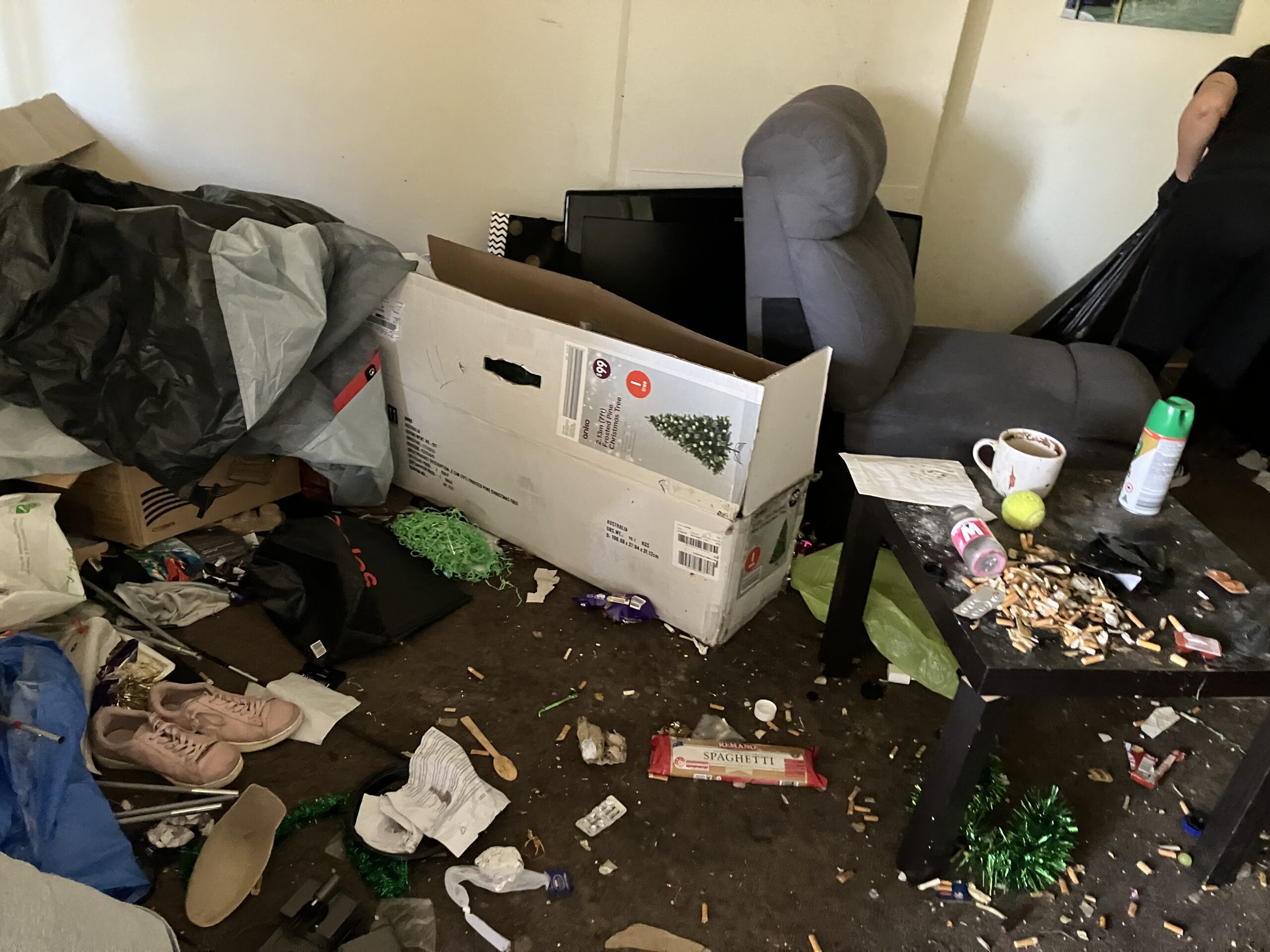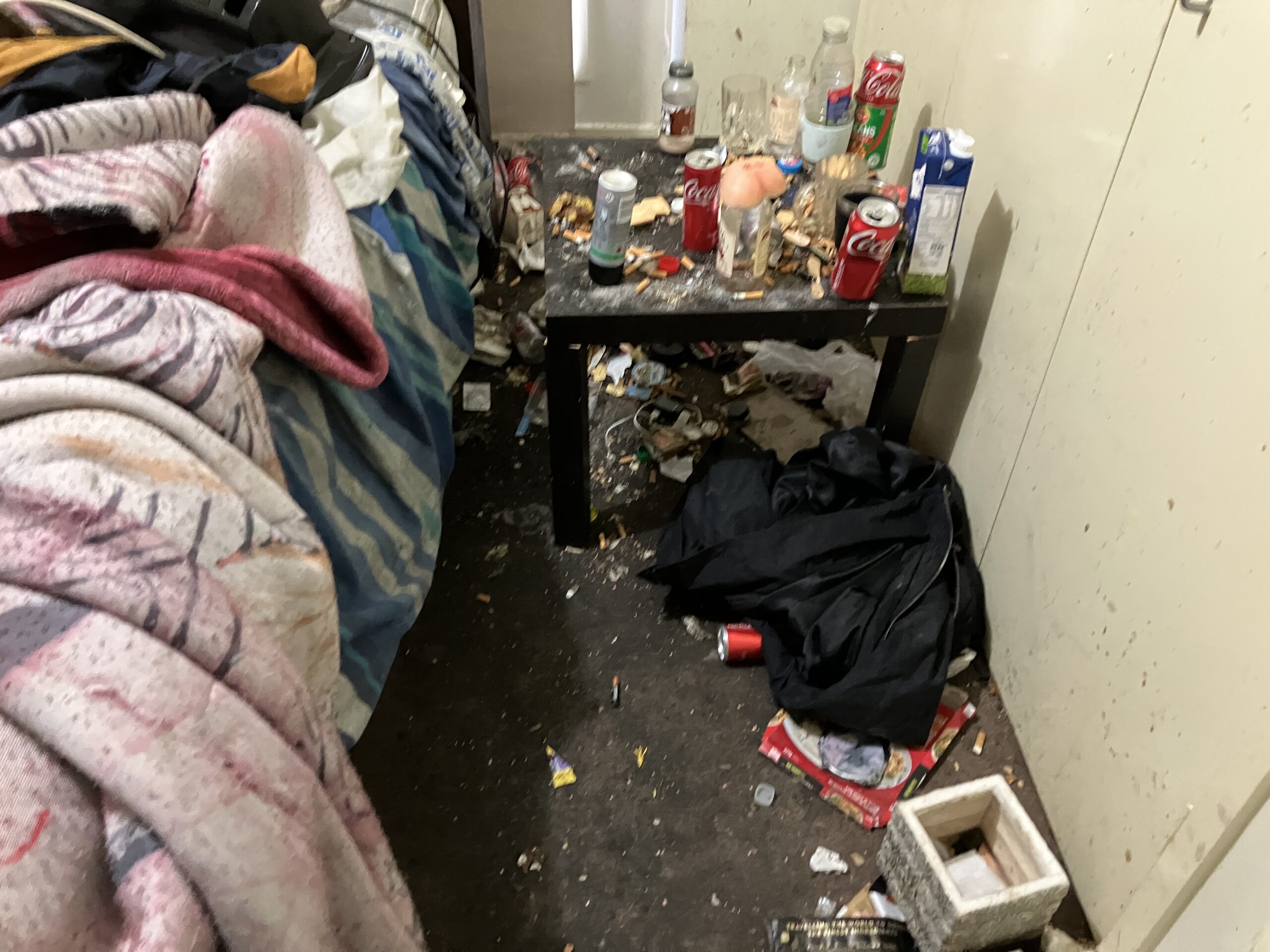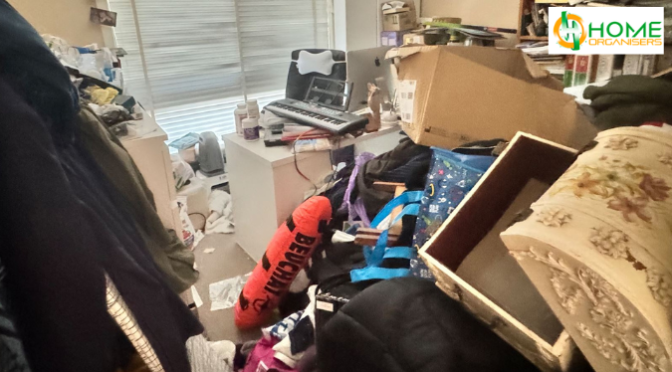Decluttering is more than just cleaning up. For people who’ve experienced trauma, it’s often tied to deep emotional pain, memories, and stress. What looks like a pile of clothes or papers to some might feel like a mountain of fear or shame to others. That’s why trauma-informed decluttering matters—and why allied health professionals must approach it with care, compassion, and understanding.
In this blog, we’ll explore what trauma-informed decluttering is, why it’s important, and how it affects not just physical space, but also mental health, emotional wellbeing, family life, productivity, and even financial stability. Whether you’re an occupational therapist, support coordinator, NDIS psychologist support, or social worker, this article will help you better support clients who feel overwhelmed by clutter.
What is Trauma-Informed Decluttering?
Trauma-informed decluttering is a gentle, respectful approach to helping people clear and organise their living spaces while being sensitive to past trauma.
Instead of rushing or focusing only on the result (a clean room), the process is guided by five key trauma-informed principles:
- Safety – Making sure the client feels safe emotionally and physically.
- Trustworthiness – Building a relationship based on honesty and reliability.
- Choice – Letting the client make their own decisions at their own pace.
- Collaboration – Working together rather than taking over.
- Empowerment – Helping the person feel stronger and more in control.
When done right, trauma-informed cleaning supports healing, reduces anxiety, and helps people feel more comfortable in their homes.

Why Does Clutter Happen in the First Place?
Clutter can build up for many reasons:
- Mental health conditions like depression, anxiety, PTSD, or ADHD
- Physical limitations or disability
- Grief and loss
- Childhood trauma or abuse
- Hoarding disorder
- Life transitions like moving house, separation, illness, or ageing
In many cases, clutter isn’t just about mess—it’s about emotional pain, lack of support, or being stuck in survival mode.
For people living with trauma, clutter can offer a strange kind of comfort or control. Letting go of objects may feel like letting go of memories, safety, or even part of themselves. This is why decluttering must never be forced or rushed.
The Role of Allied Health Professionals
Allied health professionals are in a unique position to support clients through trauma-informed decluttering. You understand the links between health, environment, and behaviour. You also know how trauma can impact daily life, decision-making, and routines.
Whether you’re helping a client stay safe at home, meet NDIS goals, or regain independence, a trauma-informed approach can make all the difference.
Your role may include:
- Referring clients to trained trauma-informed cleaning professionals
- Helping set gentle, achievable goals
- Supporting decision-making without pressure
- Encouraging self-care during the process
- Ensuring the client feels heard, respected, and safe
How Trauma-Informed Decluttering Improves Health
Living in a cluttered home can affect physical and mental health in many ways. For example:
- Trip and fall risks from cluttered floors
- Mould, dust, or pests from unclean areas
- Poor air quality
- Sleep disturbances
- Stress and anxiety
Trauma-informed cleaning focuses not just on tidying up but on improving the person’s overall health.
When a home is safer and cleaner, people are more likely to eat better, sleep better, take their medication, and look after themselves. It also supports the work of other health professionals like physiotherapists and nurses who may visit the home.

Mental and Emotional Benefits
For people with a trauma history, a cluttered space can trigger flashbacks, shame, and a constant feeling of being overwhelmed. On the flip side, a calm and organised space can help the brain feel safer.
Benefits include:
- Reduced anxiety and depression
- Improved self-esteem
- Better emotional regulation
- Less guilt and shame
- Feeling more “in control” of life
It’s important to remember that decluttering isn’t just about the house—it’s about what the house represents to the client. Being patient and understanding through the process is key.
Impact on Family and Relationships
Clutter can cause tension in families, especially when others don’t understand the emotional weight behind it.
Children may feel embarrassed to bring friends home. Partners may become frustrated or resentful. Older parents may be at risk of losing access to services or aged care support because their homes aren’t safe.
Trauma-informed decluttering can help repair these relationships by:
- Creating a neutral space for discussion
- Giving everyone in the family a voice
- Avoiding blame or shame
- Promoting teamwork and support
When families see progress—no matter how small—they often become more supportive and involved.
Supporting Productivity and Daily Functioning
A cluttered environment makes it hard to focus, plan, and get things done. For clients with executive function difficulties, trauma history, or neurodivergence (such as autism or ADHD), clutter can make everyday tasks feel impossible.
Trauma-informed cleaning can support:
- Better routines and daily structure
- More time and energy for important tasks
- Improved memory and attention
- Better access to important items like medications, papers, or appliances
- Increased ability to work from home or study
A clear space can create a clear mind—and that’s life-changing for many people.

How Mood and Well-Being are Affected
Our surroundings affect how we feel every day. Living in clutter can trigger feelings of:
- Helplessness
- Shame
- Frustration
- Sadness
- Anxiety
A trauma-informed cleaning process helps improve:
- Peace of mind – less visual “noise”
- Confidence – feeling proud of their space
- Hope – seeing a way forward
- Self-worth – feeling respected and heard
- Joy – creating a space that feels like home again
And the best part? These improvements often continue even after the decluttering is finished.
Financial and Practical Benefits
Decluttering has real-world benefits, too. People often find:
- Unpaid bills or lost items
- Clothes, food, or items they forgot they had
- Opportunities to sell or donate unused items
- Less need to buy replacements
- Lower cleaning or pest control costs
- Easier home maintenance
For NDIS participants or people on low incomes, this can be incredibly empowering. A decluttered space may also help them qualify for additional supports or services that were previously denied due to the home environment.
NDIS and Trauma-Informed Decluttering
Under the NDIS, decluttering can be funded when it’s linked to a participant’s goals, such as:
- Living independently
- Improving health and hygiene
- Creating a safe home environment
- Increasing social and community participation
When requesting support, it’s important to frame decluttering in terms of functional outcomes, not just cleaning. For example:
- “Creating space for mobility aids”
- “Reducing fall risks”
- “Supporting medication management”
- “Promoting mental health and stability”
Working with a team trained in both NDIS requirements and trauma-informed cleaning ensures the service is delivered safely, respectfully, and with the right documentation—including support from NDIS psychologist support and OT declutter assessment when required.
What Makes a Decluttering Team Trauma-Informed?
Not all decluttering services are the same. A trauma-informed cleaning team will:
- Work slowly and respectfully
- Ask for permission before moving anything
- Let the client lead the pace
- Understand emotional attachment to items
- Never shame or judge
- Offer breaks and support as needed
- Collaborate with support workers or therapists
- Celebrate small wins
They also know that sometimes, just showing up is a big step for the client—and that’s okay.
Tips for Allied Health Professionals
Here are some ways to support your clients through trauma-informed decluttering:
1. Start small
Begin with one area or one type of item (e.g. clothing, papers, food).
2. Validate their feelings
Let them know it’s okay to feel overwhelmed or unsure.
3. Break it down
Turn big tasks into small steps and celebrate progress.
4. Avoid judgment
Don’t use terms like “hoarder” or “lazy.” Use language that supports dignity.
5. Work with the right team
Partner with professionals trained in trauma-informed cleaning, and work alongside services offering NDIS psychologist support and formal OT declutter assessment reports when needed.
When Decluttering Becomes Therapeutic
For many people, decluttering is more than a clean-up—it’s a healing process.
It can mean:
- Letting go of old pain
- Creating space for something new
- Taking control after feeling powerless
- Rebuilding life one small step at a time
Trauma-informed decluttering gives people the permission and support to change their environment and their story.
Final Thoughts
Decluttering is not just about getting rid of things. For clients with trauma backgrounds, it’s about healing, safety, and self-worth. Allied health professionals play a vital role in making this possible through sensitivity, planning, and teamwork.
By recognising clutter as a form of communication—not just a problem to fix—you can help your clients feel seen, supported, and empowered.
If you’re working with clients who feel stuck, overwhelmed, or unsafe in their homes, consider referring them to a trauma-informed cleaning service. With the right support, they can create a space that supports their health, wellbeing, and future goals.
Need support with trauma-informed decluttering?
Speak with our compassionate team today. Call 03 8583 9103, email nancy@homeorganisers.com.au, or visit homeorganisers.com.au to learn how we can help.
CASE STUDIES
Case Study 1: “Marie’s Story – From Anxiety to Empowerment Through Trauma-Informed Cleaning”
Background:
Marie, 52, was referred by her NDIS psychologist support team. She had experienced domestic violence in her past, followed by years of depression and social isolation. Her small unit had become overwhelmed with clutter—piles of unopened mail, clothes, broken appliances, and personal items filled every room. She was deeply ashamed of the state of her home and had not let anyone visit for over 6 years.
The Challenge:
Marie wasn’t just dealing with “mess.” Her home had become a reflection of years of emotional pain. Attempts to clean on her own always ended in panic, tears, and fatigue. The thought of letting a stranger into her space triggered intense anxiety.
The Process:
Working alongside her OT and psychologist, Home Organisers conducted a gentle, collaborative OT declutter assessment, focusing not just on space but on emotional readiness.
Marie was reassured that the process would be slow, private, and entirely her choice. She was given the power to pause, reflect, or say “no” at any stage.
The trauma-informed cleaning team started in one corner of her bedroom—where she could still feel emotionally safe. Over six weeks, small, achievable sessions helped her reclaim one room at a time.
The Result:
Marie now enjoys a clutter-free lounge and bedroom, uses her kitchen again, and has even hosted her daughter for tea for the first time in years.
Her psychologist reported significant improvements in her anxiety levels, sleep, and confidence. Most importantly, Marie now sees her home as a place of safety—not shame.
“You didn’t just help me clean my house. You helped me feel like myself again,” she shared.
Case Study 2: “Thomas’s Recovery Journey – How Trauma-Informed Decluttering Helped Him Regain Independence”
Background:
Thomas, 37, lives with complex PTSD and OCD. He is a participant in the NDIS, supported by a team that includes a psychologist, an occupational therapist, and a support coordinator. His clutter had taken over his one-bedroom flat—hallways were blocked, his bathroom was barely usable, and his fridge hadn’t worked in over a year.
His NDIS psychologist support team raised concerns about hygiene, safety, and his declining mental health. But Thomas resisted help, fearing judgment, loss of control, and being forced to throw away items he believed he needed.
The Challenge:
Traditional cleaning services had previously refused the job due to the level of clutter and Thomas’s anxiety. He had never completed a decluttering session without breaking down or becoming overwhelmed.
The Process:
After an initial consultation and an OT declutter assessment, Home Organisers developed a trauma-informed plan in close partnership with Thomas’s allied health team.
The trauma-informed cleaning team introduced themselves gently and never touched an item without consent. Each session lasted only 90 minutes and included scheduled breaks, debriefs, and regular check-ins with his psychologist.
Instead of focusing on “what to throw away,” they focused on “what would help Thomas feel better.”
The Result:
After eight weeks, Thomas had a clean and functioning bathroom, a walkable kitchen, and an open living space. He began sleeping better, preparing basic meals, and even started drawing again—something he hadn’t done in over a decade.
His support coordinator later shared,
“This was the first time Thomas stuck with a decluttering plan. The trauma-informed approach changed everything.”
Today, Thomas continues to work with Home Organisers for light maintenance support every month and is working toward moving into a larger unit in the next year.
FAQs on Trauma-Informed Decluttering for Allied Health Professionals
- What if I’m too ashamed to let someone see my cluttered home?
A gentle, validating blog that addresses the fear of judgment, explains how trauma-informed decluttering is shame-free, and encourages clients to take the first brave step.
- How can decluttering actually improve my mental health?
An emotional and practical post exploring the connection between environment and mental wellbeing, and how trauma-informed support reduces anxiety, stress, and emotional overwhelm.
- I want help, but I don’t know where to start—what happens in the first session?
A transparent, calming breakdown of the first contact and session, written in everyday language for clients and carers who may be anxious or unsure.
- My past trauma makes it hard to let go—how do you help without pushing me?
A deeply empathetic FAQ explaining how the team respects emotional attachment to items and how decisions are always guided by the client, not rushed.
- Can decluttering really help me feel safe in my home again?
Explores how clutter impacts physical and emotional safety—and how trauma-informed cleaning can restore both with dignity and care.
- I’m an NDIS participant—can this service be covered under my plan?
Answers common questions about funding, how it relates to daily living goals, and how Home Organisers works with OTs and support coordinators to help.
- How do you work with my OT or psychologist during decluttering?
Details the collaboration process, including communication with professionals offering NDIS psychologist support and preparing an OT declutter assessment, so everything is aligned.
- I’ve tried to declutter before and failed—what makes this different?
A motivational, heart-to-heart blog showing how trauma-informed care provides structure, support, and emotional safety—so clients don’t have to face it alone.
- How do you make sure I feel in control during the process?
Clarifies how autonomy, choice, and empowerment are built into every step, and how clients are never forced or pressured to let go of anything.
- Will your team understand my anxiety and triggers?
Assures readers that the team is trained in trauma-informed support, knows how to work with people sensitively, and can adapt sessions based on emotional needs.


